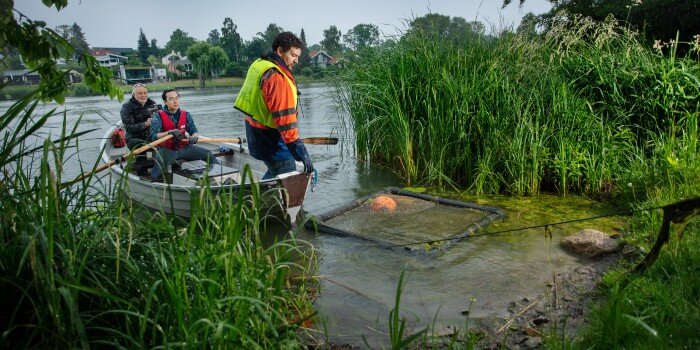
Credit: Technical University of DenmarkAn electrode project was successfully implemented in Lake Sllerd to oxygenate the lake bed. This method should now undergo large-scale demonstration testing.Just over 75% of European and Danish lakes have problems with oxygen depletion or algae. This is due to the bad habit of dumping wastewater with high phosphorus levels directly into the lakes. Because the sediment at the bottom is no longer rich in oxygen, bacteria cannot break down the dead plants, fish, or algae. This makes the lakes appear murky and smelly.Many different methods of oxygenating lakes' bottoms have been tried in recent years. These initiatives, however, have been costly and limited in their effectiveness, according to Professor Stefan Trapp, DTU Environment.Our new method is simple and affordable. Stefan Trapp says that the new method was tested in the laboratory, then in a pilot project at Lake Sllerd. The results were very promising.Encapsulated phosphorusStefan Trapp was inspired to use electrodes to oxygenate the lakebed by his colleague Yifeng, who also uses this method in other fields.In practice, this involves lowering two steel meshes into each end of the lake. They are connected by a wire, and create an electric battery. Karl Haxthausen from DTU Environment has been responsible for the practical aspects of the work."This allows bacteria to break down dead organic matter just like oxygen. The whole process is done without the production of unwanted methane. Karl Haxthausen says that the removal of electrons can also alter the lake's chemistry, causing the phosphorus bind to the sediment and resulting in its immobilization."Test a whole lakeThe new method has produced a remarkable result in the encapsulation. There is more phosphorus in one centimetre than there is in 10 metre deep water.The pilot project with two steel meshes in Lake Sllerd began in summer 2019 and is now complete.Stefan Trapp says, "Our results are so promising, we would like to do a large demonstration trial where we not just use a few small 4x4 metre meshes but also test our method over an entire lakefor instance, an area of 100x100 metres."The new approach could be a major player in future lake remediation if the project's outcome is satisfactory. It will also be fascinating to see how it can be used in marine areas with similar oxygen depletion problems.Explore more Small volcanic lakes tapping into huge underground reservoirs
